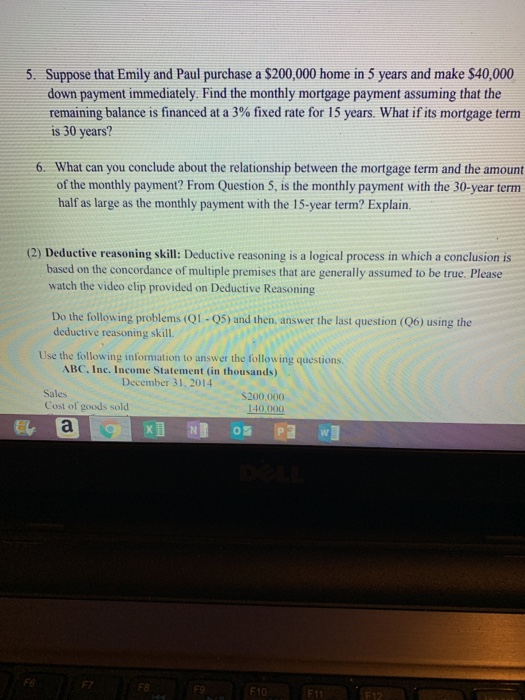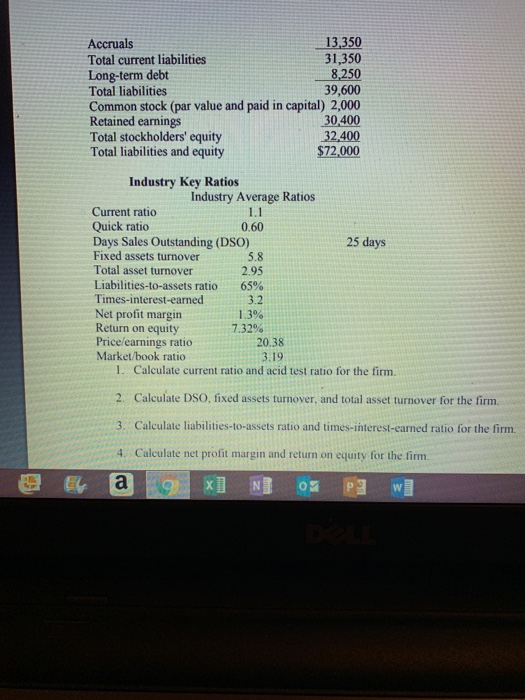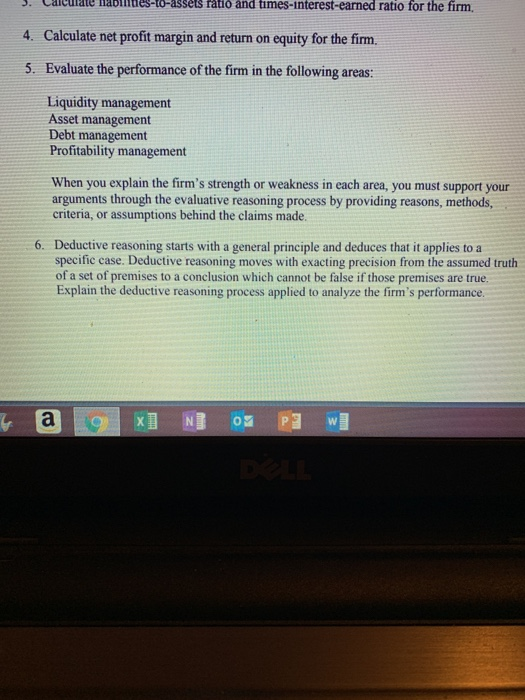Answered step by step
Verified Expert Solution
Question
1 Approved Answer
5. Suppose that Emily and Paul purchase a $200,000 home in 5 years and make $40,000 down payment immediately. Find the monthly mortgage payment assuming



 5. Suppose that Emily and Paul purchase a $200,000 home in 5 years and make $40,000 down payment immediately. Find the monthly mortgage payment assuming that the remaining balance is financed at a 3% fixed rate for 15 years. What if its mortgage term is 30 years? What can you conclude about the relationship between the mortgage term and the amount of the monthly payment? From Question 5, is the monthly payment with the 30-year term half as large as the monthly payment with the 15-year term? Explain 6. (2) Deductive reasoning skill: Deductive reasoning is a logical process in which a conclusion is based on the concordance of multiple premises that are generally assumed to be true. Please watch the video clip provided on Deductive Reasoning Do the following problems (01 - Q5) and then, answer the last question (Q6) using the deductive reasoning skill. Use the following information to answer the following questions. ABC. Inc. Income Statement (in thousands) December 31, 2014 Sales Cost of goods sold $200,000 140.000 t n thousands December 31,2014 $200,000 Sales Cost of goods sold Gross profit on sales Operating expenses Operating income (EBIT) Interest expense Earnings before tax Income tax Net income available to common stockholders $1,950 Number of shares outstanding Market price per share 140,000 60,000 56,000 4,000 1.000 3,000 1050 1, 500 S22 ABC, Inc. Balance Sheet (in thousands) December 31, 2014 Assets Cash Accounts receivable Inventories Total current assets Gross fixed assets Accumulated depreciation Net fixed assets Total assets Liabilities and Equity Accounts payable $2,000 17,800 28,500 70,000 26,500 43.500 $72,000 $18,000 13,350 Accruals Total current liabilities Long-term debt Total liabilities Common stock (par value and paid in capital) 2,000 Retained earnings Total stockholders' equity Total liabilities and equity 31,350 8.250 39,600 30,400 32,400 $72,000 Industry Key Ratios Industry Average Ratios 1.1 0.60 Current ratio Quick ratio Days Sales Outstanding (DSO) Fixed assets turnover Total asset turnover Liabilities-to-assets ratio 65% Times-interest-earned Net profit margin Return on equity Price/earnings ratio 25 days 5.8 2.95 3.2 1.3% 7.32% 20.38 3.19 Market/book ratio 1. Calculate current ratio and acid test ratio for the firm. 2. Calculate DSO, fixed assets turnover, and total asset turnover for the firm. 3. Calculate liabilities-to-assets ratio and times-interest-earned ratio for the firm 4. Calculate net profit margin and return on equity for the firm. dichate habllies-to-assets ratio and times-interest-earned ratio for the firm, Calculate net profit margin and return on equity for the firm. 4. 5. Evaluate the performance of the firm in the following areas: Liquidity management Asset management Debt management Profitability management When you explain the firm's strength or weakness in each area, you must support your arguments through the evaluative reasoning process by providing reasons, methods, criteria, or assumptions behind the claims made. Deductive reasoning starts with a general principle and deduces that it applies to a specific case. Deductive reasoning moves with exacting precision from the assumed truth of a set of premises to a conclusion which cannot be false if those premises are true Explain the deductive reasoning process applied to analyze the firm's performance 6. 0%
5. Suppose that Emily and Paul purchase a $200,000 home in 5 years and make $40,000 down payment immediately. Find the monthly mortgage payment assuming that the remaining balance is financed at a 3% fixed rate for 15 years. What if its mortgage term is 30 years? What can you conclude about the relationship between the mortgage term and the amount of the monthly payment? From Question 5, is the monthly payment with the 30-year term half as large as the monthly payment with the 15-year term? Explain 6. (2) Deductive reasoning skill: Deductive reasoning is a logical process in which a conclusion is based on the concordance of multiple premises that are generally assumed to be true. Please watch the video clip provided on Deductive Reasoning Do the following problems (01 - Q5) and then, answer the last question (Q6) using the deductive reasoning skill. Use the following information to answer the following questions. ABC. Inc. Income Statement (in thousands) December 31, 2014 Sales Cost of goods sold $200,000 140.000 t n thousands December 31,2014 $200,000 Sales Cost of goods sold Gross profit on sales Operating expenses Operating income (EBIT) Interest expense Earnings before tax Income tax Net income available to common stockholders $1,950 Number of shares outstanding Market price per share 140,000 60,000 56,000 4,000 1.000 3,000 1050 1, 500 S22 ABC, Inc. Balance Sheet (in thousands) December 31, 2014 Assets Cash Accounts receivable Inventories Total current assets Gross fixed assets Accumulated depreciation Net fixed assets Total assets Liabilities and Equity Accounts payable $2,000 17,800 28,500 70,000 26,500 43.500 $72,000 $18,000 13,350 Accruals Total current liabilities Long-term debt Total liabilities Common stock (par value and paid in capital) 2,000 Retained earnings Total stockholders' equity Total liabilities and equity 31,350 8.250 39,600 30,400 32,400 $72,000 Industry Key Ratios Industry Average Ratios 1.1 0.60 Current ratio Quick ratio Days Sales Outstanding (DSO) Fixed assets turnover Total asset turnover Liabilities-to-assets ratio 65% Times-interest-earned Net profit margin Return on equity Price/earnings ratio 25 days 5.8 2.95 3.2 1.3% 7.32% 20.38 3.19 Market/book ratio 1. Calculate current ratio and acid test ratio for the firm. 2. Calculate DSO, fixed assets turnover, and total asset turnover for the firm. 3. Calculate liabilities-to-assets ratio and times-interest-earned ratio for the firm 4. Calculate net profit margin and return on equity for the firm. dichate habllies-to-assets ratio and times-interest-earned ratio for the firm, Calculate net profit margin and return on equity for the firm. 4. 5. Evaluate the performance of the firm in the following areas: Liquidity management Asset management Debt management Profitability management When you explain the firm's strength or weakness in each area, you must support your arguments through the evaluative reasoning process by providing reasons, methods, criteria, or assumptions behind the claims made. Deductive reasoning starts with a general principle and deduces that it applies to a specific case. Deductive reasoning moves with exacting precision from the assumed truth of a set of premises to a conclusion which cannot be false if those premises are true Explain the deductive reasoning process applied to analyze the firm's performance 6. 0%




Step by Step Solution
There are 3 Steps involved in it
Step: 1

Get Instant Access to Expert-Tailored Solutions
See step-by-step solutions with expert insights and AI powered tools for academic success
Step: 2

Step: 3

Ace Your Homework with AI
Get the answers you need in no time with our AI-driven, step-by-step assistance
Get Started


